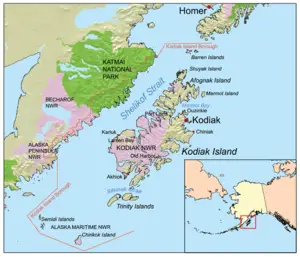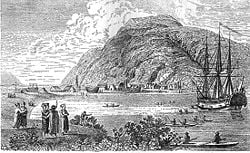Kodiak Island
Kodiak Island is a large island on the south coast of the U.S. state of Alaska, separated from the Alaska mainland by the Shelikof Strait. It is the largest island in the Kodiak Archipelago and at 8975 km² (3465 squares mile) in area is the largest island in Alaska and the second-largest island in the United States (after the Big Island of Hawaii). It is 160 km (100 miles) long and in width ranges from 16 to 96 km (10 to 60 miles).
Kodiak Island is mountainous and heavily forested in the north and east, but fairly treeless on the south. The island has many ice-free, deep bays that provide sheltered anchorages for boats. The southwestern two-thirds of the island, like much of the Kodiak Archipelago, is part of Kodiak National Wildlife Refuge.
Kodiak Island is part of the Kodiak Island Borough of Alaska. The largest town on the island is Kodiak. Other settlements include the villages of Akhiok, Old Harbor, Karluk, Larsen Bay, Port Lions, and Ouzinki. Kodiak is also home to a large Coast Guard station, Integrated Support Command Kodiak.
The Kodiak Bear and the king crab are native to the island. The fishing industry is the most important economic activity on the island; fisheries include Pacific salmon, Pacific halibut, and crab. The Karluk River is famous for its salmon run. Logging, ranching, numerous canneries, and some copper mining are also prevalent.
History
Kodiak is the ancestral land of the Koniaga, an Alutiiq nation of Alaska Natives. The original inhabitants subsisted by hunting, fishing, farming, and gathering. The first outsiders to settle on the island were Russian explorers under Grigory Shelikhov, who founded a Russian settlement on Kodiak Island at Three Saints Bay near the present-day village of Old Harbor in 1784. Following the 1867 Alaska purchase the island became part of the United States; Americans settled there and engaged in hunting and fox farming.
The Koniagas had been studied by European explorers, who marveled at their practice of male concubinage: "A Kodiak mother will select her handsomest and most promising boy, and dress and rear him as a girl, teaching him only domestic duties, keeping him at women's work, associating him with women and girls, in order to render his effeminacy complete. Arriving at the age of ten or fifteen years, he is married to some wealthy man who regards such a companion as a great acquisition. These male concubines are called Achnutschik or Schopans'" (Richard Francis Burton in his Terminal Essay, after Holmberg, Langsdorff, Joseph Billings, Choris, Yuri Lisiansky and Marchand)
Kodiak Island was explored in 1763 by Russian fur trader Stepan Glotov. The island was the location of the first permanent Russian settlement in Alaska, founded by Grigory Shelikhov, a fur trader, on Three Saints Bay in 1784. The settlement was moved to the site of present-day Kodiak in 1792 and became the center of Russian fur trading. In 1912 the eruption of Novarupta on the mainland (erroneously attributed at one time to the more famous Mount Katmai) blanketed the island with volcanic ash, causing widespread destruction and loss of life. The island was also hit by the 1964 Good Friday Earthquake and tsunami, which destroyed much of the town.
Kodiak Archipelago
The Kodiak Archipelago is an archipelago, or group of islands, south of the mainland of the United States state of Alaska, about 405 km (252 miles) by air south of Anchorage in the Gulf of Alaska. The largest island in the archipelago is Kodiak Island, the second largest island in the United States. The second largest island in the archipelago is Afognak, north of Kodiak Island, which has been extensively logged. To the north is Shuyak—an island of deep bays which is now in conservation. South of Kodiak are Tugidak and Sitkinak. The archipelago is about 285 km (177 miles) long and 108 km (67 miles) across, from the Barren Islands on the north to Chirikof Island and the Semidi Islands group on the south. The Archipelago contains 13,890 square kilometres (5,363 mile²) of land. The Kodiak Archipelago contains about 40 small glaciers, numerous streams and hundreds of species of land and marine animals. Much of its land is forested.
The Kodiak Island Burough contains all of the Kodiak Archipelago and some lands on the mainland. The Kodiak National Wildlife Refuge encompasses a large percentage of the land in the archipelago.
The Archaeological Record during the Holocene
"The archaeological record contains several seemingly abrupt changes suggesting population replacements to some, but the current view, followed here, is that there has been long-term cultural continuity."[1] (Ames et. al., p.61)
The Late Holocene contains four cultural periods: the Ealy Kachemak, the Late Kachemak, the Koniag, and the Alutiiq. Each period will be broken down by time period, also including the significance of each.
- Ealy Kachemak (1850 B.C.E. - 500 B.C.E.) = The period is marked by the shift in mobility patterns: residential foragers to logistical collectors. Dwellings were small in size. Technology and subsistence activities were made more efficient. More efficient ways of processing food were introduced. Material remains include toggling harpoons, netweights, ground slate points, nets, ulus (chopping knife). The Ocean Bay people were the first to inhabit the area. They were considered to be a maritime people, but exploited both marine and terrestrial resources, including mammals and fish. Their only hunting kit included hooks, lines, harpoons, and lances with chipped stone points. By the Middle Holocene, more specialized tool kits were introduced. Originally living in small, dispersed settlements, the small 2-3m tents were replaced by small pit houses around 2000 B.C.E.
- Late Kachemak (500 B.C.E. - 1200 C.E.) = The period is marked by large populations. Logistical patterns of mobility kept increasing, and community sizes increased, having up to ten dwellings. Storage facilities are also introduced. Mortuary practices are considered to be elaborate, and the finding of labrets suggest that social differentiation increased. Craft specialization increased as well.
- Koniag (1200 C.E. - European Contact) = The period is marked by the population reaching its peak. Houses and settlement sizes continued to increase, giving evidence towards social ranking. Architecture was beginning to be more elaborate and storage features kept increasing in size. Shift in location toward the coast suggests for having better access at marine resources, specifically whales. "There is also evidence of intensified salmon fishing, food production and processing specilizations, exchange, and investment in carpentry". [1] (Ames et. al., p.62)
- Alutiiq (Modern) = These islands are the original or traditional homes of the Alutiiqu (previously Koniag) peoples. The coastal environment provided excellent productivity for these people, as the terrestrial environment seemed somewhat low or lacked natural resources.
ReferencesISBN links support NWE through referral fees
External links
Credits
New World Encyclopedia writers and editors rewrote and completed the Wikipedia article in accordance with New World Encyclopedia standards. This article abides by terms of the Creative Commons CC-by-sa 3.0 License (CC-by-sa), which may be used and disseminated with proper attribution. Credit is due under the terms of this license that can reference both the New World Encyclopedia contributors and the selfless volunteer contributors of the Wikimedia Foundation. To cite this article click here for a list of acceptable citing formats.The history of earlier contributions by wikipedians is accessible to researchers here:
The history of this article since it was imported to New World Encyclopedia:
Note: Some restrictions may apply to use of individual images which are separately licensed.

